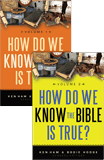Inerrancy and the Test of Truth
The doctrine of the inerrancy of Scripture is one of Christianity’s most important doctrines to be defended, especially as skeptical forces increase their attack on the truthfulness of the Bible. In this article, I will define the foundational concept of truth, review the case for the utter truthfulness (or inerrancy) of Scripture, and then discuss how the Bible passes the “test of truth” even down to the details of its claims.
What Is Truth?
The concept of inerrancy is based on the correspondence view of truth and the law of non-contradiction.
According to the correspondence view of truth, truth is a statement or idea which corresponds to reality. In other words, a statement is true if and only if it matches the way things really are. My affirmations should match reality. I can say that the earth is flat or that the sky is green—but that doesn't make it so!
Implied in the correspondence view of truth is the law of non-contradiction: something cannot both be and not be at the same time and in the same respect. For example, “Rain is falling on my car right now” and “Rain is not falling on my car right now” cannot both be true. Truth is coherent. Anything true will be consistent with itself. If two statements absolutely contradict one another, they cannot both be true; they cannot both match reality. But two statements could both be false if neither of them corresponds to reality. If I claim that I only had corn flakes for breakfast this morning, and then claim that I only had cheerios for breakfast this morning, there is a problem with my claims. These exclusive claims cannot both be true. In fact, it would turn out that neither is true if I didn’t actually have breakfast at all.
It matters to the Bible writers that their truth claims match the way things really are.
Throughout Scripture, there is an assumption of truth as correspondence to reality. It matters to the Bible writers that their truth claims match the way things really are. For example, the apostles knew that their claim that Jesus rose from the dead had to match reality. If the Resurrection didn’t actually take place, then our faith is in vain, and the apostles were liars. The Apostle Paul put it this way: “[If the dead rise not], we are even found to be misrepresenting God, because we testified about God that he raised up Christ, whom he did not raise if it is true that the dead are not raised” (1 Corinthians 15:14–15). Paul confessed that he would be a false witness (a liar) if his truth claim didn’t match reality. The correspondence view of truth is assumed here.1
The biblical conception of truth always entails a correspondence between the intended assertion and reality. This understanding of truth culminates in the claim of Jesus to be the Truth2—the disclosure of Ultimate Reality, the Source of anything else that is real.3 Christ embodies that Reality as a Divine Person who reveals the truth to us in his Word, the Scriptures.4
The Case for Inerrancy
Now let’s summarize the deductive argument for inerrancy (the utter truthfulness of the Bible). This doctrine technically applies to the original text of the 66 books of Scripture. But to the extent that manuscripts and translations reflect the original text, it also applies to what we have today. Fortunately, we can have a high degree of certainty regarding the actual wording of the original text for the vast majority of passages in both the Old and New Testaments, and many translations provide a careful representation of the biblical text. Here’s the argument for inerrancy:
- Premise A: Every utterance of God is perfect and thus free from error.
- Premise B: All the truth claims of the Bible writers are the utterances of God.
- Conclusion: All the truth claims of the Bible writers are free from error.
Premise A is supported by the teaching that God cannot lie (Titus 1:2) and that he knows everything (1 John 3:20). God cannot say anything contrary to the way things really are. He is morally perfect and will not lead anyone astray, especially since he is omniscient. Bible writers declare that the words of God are pure (Psalm 12:6; Proverbs 30:5). Paul calls Scripture the “word of truth” (2 Timothy 2:15), and he says that the truth excludes the possibility of lying (Romans 9:1). There is nothing spoken by God that is contrary to what is true.
Premise B is supported by 2 Timothy 3:16 (NIV), which says, “all Scripture is God-breathed” and other scriptures that refer to the words of Moses, the other prophets, and the apostles as actual words of God.
That is the deductive argument for inerrancy. If Premise A and B are true, then the Conclusion (that all the truth claims of the Bible writers are free from error) must be true. If the Conclusion is true, then we must approach Scripture from the stance of faith, trusting that when properly interpreted no errors will be found in Scripture, no matter how small. Nothing will be stated as a fact that does not correspond to the way things really are.5
If anyone were to suggest that there are assertions in Scripture that don’t accurately represent reality, then he would be implying that God is guilty of knowingly making statements that are factually untrue. But Titus 1:2 says that God cannot lie. So we believe that the Bible will always pass the test of truth.
The Test of Truth
The test of truth attempts to see the relationship between a biblical author’s claims and reality. The test first asks, “Does God (and the human author) intend through this statement to make a claim about reality? If so, what is the claim?” Then it asks, “How does this intended communication match reality?” and “How does this truth-claim cohere with other truth-claims of Scripture?” Those who believe that the Bible is God-breathed should never question whether actual truth-claims match reality. If the Bible is God-breathed, every claim about reality in the original text of Scripture is true, and none of them will ever be shown to be false when properly interpreted. The evidence points us in the direction of that truth. Though not every detail has been confirmed, we can confirm the historicity of the Bible through other historical writings and archaeology, and we can show that apparent discrepancies have possible logical solutions. When an apparent discrepancy is difficult to solve, we don’t force a harmonization, but give the benefit of the doubt to the Bible and assume that every actual truth claim is consistent with reality in some way or another, even if we don’t understand how.
If the Bible is God-breathed, every claim about reality in the original text of Scripture is true, and none of them will ever be shown to be false when properly interpreted.
For example, when the Gospel of John refers to two angels sitting in the tomb of Jesus after the Resurrection (John 20:12) and the Gospel of Mark speaks of one angel sitting in the tomb (Mark 16:5), we should assume that John is right and that Mark is also right, even if we can’t understand how they can be reconciled. In this case, it’s easy since Mark doesn’t say there was only one angel. There were actually two angels, but Mark was only concerned about pointing out one. How some apparently conflicting accounts are both (or all) truly accurate we may never know. But it is safe to say that since all accounts are inspired by God and thus wholly true, attempting to harmonize the texts will normally get us closer to an accurate understanding of what happened than not attempting to harmonize the text. This is similar to the fact that a detective will likely come closer to figuring out what happened at a crime scene if he examines reports from a variety of reliable witnesses and tries to piece the incident together.
Both the internal and external evidence of the Gospels point to an authorial concern for careful accuracy (our deductive proof for inerrancy is supported by inductive proof). The author Luke told Theophilus that he (Luke) had a “perfect understanding” of what he was writing about, and he wanted Theophilus to know “the certainty” of what happened (Luke 1:1–4). He mentioned eyewitnesses as his sources. Looking at the rest of the gospel, we can see that Luke dated events by known historical figures, such as Caesar Augustus and Cyrenius. These things are confirmed by historians and archaeologists. The famous archaeologist Sir William Ramsay said, “Luke's history is unsurpassed in respect to its trustworthiness.”6
External evidence for the historicity of the details of the gospels also includes Papias (contemporary of Apostle John) saying,
This also the presbyter said: Mark, having become the interpreter of Peter, wrote down accurately, though not in order, whatsoever he remembered of the things said or done by Christ. . . .
Mark committed no error while he thus wrote some things as he remembered them. For he was careful of one thing, not to omit any of the things which he had heard, and not to state any of them falsely.7
So here is extra-biblical evidence attesting to the full accuracy of Mark’s gospel, with an acknowledgment that it wasn’t necessarily presented in chronological order.
Beyond these examples of internal and external evidence, we must return to the fact that these gospels are God-breathed. How could the “God of truth,” whose “Word is pure,” contaminate his Word with claims about reality that are not in some sense true (corresponding to reality)?
Science and the Bible
I think one of the biggest problems we face in biblical scholarship today is the pressure to conform to the consensus opinion of the mainstream scientific community. Many biblical scholars interpret Genesis 6–9 as teaching a local or regional flood because the scientific establishment has “proven” that the fossil record demonstrates millions of years of evolution instead of evidence of a worldwide Flood. Many of these same scholars impose a theory of long ages on the days of Genesis 1 because the scientific establishment has convinced them that the earth is billions of years old. Some, like Peter Enns, say that the Apostle Paul erroneously believed that Adam was a historical person.8
Enns thinks Paul was wrong because the scientific establishment persuaded him that man is the product of a long process of evolution. Enns and many other biblical scholars today make the mistake of putting their faith in the majority of the scientific community rather than interpreting Genesis 1–11 as Jesus and the Apostles interpreted it—as straightforward history.
Jesus accepted all the people and events of the Old Testament as actually and accurately historical.
Jesus never challenged the history of the Bible. Jesus accepted all the people and events of the Old Testament as actually and accurately historical. He mentions them in his teaching and sometimes the point of his reference to them rested on the historical validity of the accounts. Matthew 12:41 says, “[Nineveh] repented at the preaching of Jonah, and behold, something greater than Jonah is here.” And in Matthew 24:37 Jesus prophesied, “For as were the days of Noah, so will be the coming of the Son of Man.” Elsewhere Jesus warned, “If the mighty works done in you had been done in Sodom, it would have remained until this day. But I tell you that it will be more tolerable on the day of judgment for the land of Sodom than for you” (Matthew 11:23–24).
It is obvious from Romans 5 that Paul understood Adam as a historical person. Peter took the Flood as literal and global (2 Peter 3). We are not permitted by Jesus and the apostles to understand the first few chapters of Genesis as nonhistorical literature.
If we resist the pressure from the scientific establishment (the new “ultimate authority” in our society) and interpret the scientific evidence in light of Scripture rather than the other way around, we will see less conflict between the Bible and science, and have fewer alleged discrepancies to try to explain.
Conclusion
If the Bible is verbally inspired (God-breathed down to the very words), then there will be nothing in Scripture that is not true when properly understood, even when written by men with limited and even erroneous views of the world. I am speaking of not just the “main points” but also “minor details.” God is powerful enough to keep the Bible writers from crossing over the line from the true to the false. If everything in Scripture really is the Word of God, then that is what he did—he kept them from claiming or teaching anything contrary to the way things really are.
This article is slightly revised from an article that appeared in the Renewanation Review® magazine.
Footnotes
- What about other views of truth, like the pragmatic view or the coherence view? I consider them good tests of truth, but not good definitions of truth. A claim needs to be coherent to be true, but there are false claims that could be considered coherent. That doesn’t make them true. (For example, a murderer could put together an internally consistent story that placed him away from the crime scene, but if the story contradicted what really happened, it would still be false.) Truth also should “work,” but sometimes false views can “work” too. (For example, the theory of evolution “works” in some sense as an overarching explanation for even the social sciences, but that doesn’t mean that everything actually evolved from a single cell.) The pragmatic theory can only be used as a test, not as a definition of truth.
- John 14:6.
- “As God the Son, the Word is indeed the source of all truth.” Alan Padgett and Patrick Keifert eds., “I Am the Truth” in But Is It All True? (Grand Rapids, MI: William B. Eerdman’s, 2006),107.
- Jesus said to the Father in his High Priestly Prayer, “Your word is truth” (John 17:17).
- This applies to the assertions of the Bible writers, not necessarily those they quote. The Bible records people’s lies. For example, the Bible quotes the words of Jacob when he told his father that he was Esau.
- Sir William Ramsay, St. Paul The Traveler and Roman Citizen (Grand Rapids, MI: Baker Book House, 1962), 81.
- The Church History of Eusebius, from Vol. 1 of Nicene and Post-Nicene Fathers, compiled by Philip Schaff. (Edinburgh: T&T Clark), 172–173, https://www.ccel.org/ccel/schaff/npnf201.iii.viii.xxxix.html#iii.viii.xxxix-Page_173.
- In his The Evolution of Adam, Enns argues that even though Paul’s belief that Adam was the first human contradicted the way evolution happened, this has no bearing on whether or not the gospel is true.
Recommended Resources

Answers in Genesis is an apologetics ministry, dedicated to helping Christians defend their faith and proclaim the good news of Jesus Christ.
- Customer Service 800.778.3390
- © 2024 Answers in Genesis






